Summary
This report reviews the economic benefits that can be achieved from reduced tillage. There are opportunities to maximise yields and gross margins whilst making savings to labour, machinery and fuel costs. Often reduced tillage is used in combination with other pillars of conservation agriculture, a wider rotation and continual soil cover. Increased management is often required by growers, but the benefits can assist in a sustainable arable system, underpinning an Integrated Farm Management (IFM) approach.
Improvements to soil structure by adopting reduced tillage, can also lead to less compaction and erosion, but good drainage is essential on certain soil types to keep seed and root zones free from waterlogging. Benefits of reduced tillage also include improved soil resilience which will help with future climate and weather patterns.
Fewer mechanical intrusions will help with soil biology, but there are nearly as many pitfalls as benefits if careful management is not implemented. The report identifies the challenges surrounding grass weeds, slugs and crop establishment. Healthier soils can help with nutrient recycling but crop residues and nitrous oxide emissions can replace carbon dioxide saved from reduced tractor fuel use. Reducing cultivations also has wider environmental benefits to both farmland biodiversity and ecosystems.
The United Kingdom’s agricultural production will need to increase its productivity to compete on a global stage and the economic benefits of reduced tillage could assist in achieving this aim. The reduced tillage benefits, of energy saving and soil protection, may attract financial support in future domestic agricultural policy.
Download the full report below.



